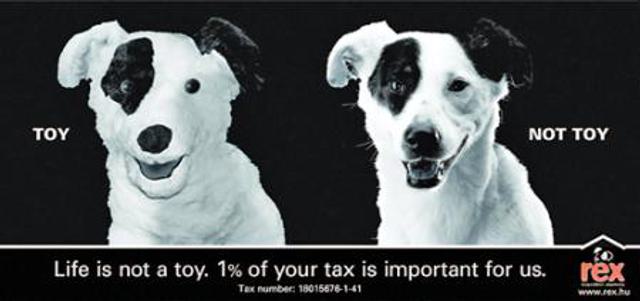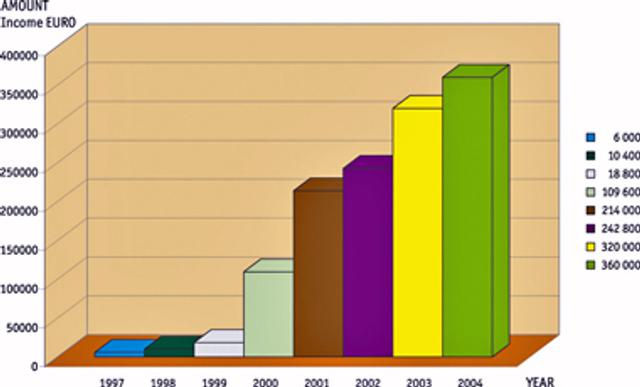Rex Dog Shelter: ‘A pet is not a toy’ campaign
- Exhibited by
- CSDF Hungary.
- Added
- June 11, 2010
- Medium of Communication
- Broadcast and television, direct mail, online, radio
- Target Audience
- Regular gift
- Type of Charity
- Environmental / animals
- Country of Origin
- Hungary
- Date of first appearance
- 2000
SOFII’s view
This is a ‘percentage’ campaign, one of Hungary’s first multi-media campaigns aimed at getting the public to sign over their one per cent entitlement – the sliver of their personal income tax that they are entitled to steer towards the nonprofit of their choice. Many organisations have now successfully followed the Rex Foundation’s lead, with good results. One important benefit from these campaigns is the incidence of successful cooperation between nonprofit organisations, their advertising or media advisers and commercial sponsors and donors.
Creator / originator
Rex Dog Shelter Foundation and Scholz and Friends advertising agency.
Summary / objectives
The premise of this campaign is simple. We are responsible for animals. Animals can feel happy and suffer as well, not like a toy that we can get rid of with impunity if we get tired of it. Almost everybody has had a toy that he/she neglected later on or simply threw out. What if people act similarly with their dogs? Unfortunately, people are constantly doing so.
Based on this powerful message, in 2004 REX Dog Shelter made one of the most successful one per cent tax campaigns in Hungary. The objectives included
- A financial return from the one per cent tax of €320,000 minimum.
- To strengthen the image of the Rex Foundation.
- To draw attention to the responsibility of keeping animals.
- To promote respect for animals.
Background
In 2000:
Rex was one of the first NGOs in Hungary to use a large multi-media campaign for the one per cent. This was a ground-breaking attempt that paid off highly.
In the 2004 campaign:
- Rex appeared on TV, radio and billboards reaching a wide target audience to build its image.
- In the second period advertisements appeared in national newspapers, with the tax number.'
- In the last two weeks of the campaign, REX posted direct mail letters – timed to coincide with when most taxpayers decided on and delivered their declaration of the one per cent tax.
The media they used included TV (commercial and public), radio (Danubius, Info, Budapest), print (monthly, weekly and daily newspapers), billboards (Budapest and area) and info-screen (Metro stations). Direct mail was sent in five Budapest districts and two towns. The Internet was also used – banners, games, downloadable advertising and on the tax declaration form.
Special characteristics
The campaign integrated numerous different types of media successfully. The message was simple, clear, but not over explained. The creative design showed an interesting, unusual and surprising situation that created a strong emotional effect and made people think and act. This is also a great example of a successful cooperation between a professional advertising agency and a nonprofit organisation.It is one of the few examples of using a strategic approach and building up the campaign and the brand over the years.
Costs
€39,596.
Results
Primary Results
- Income: 360 000 EUR
- A return of investment of nine to one.
Secondary/additional results
- During the campaign period income from donations increased dramatically.
- The campaign won the Golden Effie (one of the most prestigious awards in advertising).
- Thirty-five new volunteers joined REX.
- REX won four permanent supporters for their foundation
Merits
This was a pioneering approach, which has been influential in many similar campaigns.
Other relevant information
Adapted from CSDF’s 2006 publication Mission Possible.
 View original image
View original image
 View original image
View original image
Also in Categories
-
- Digital fundraising
-
















